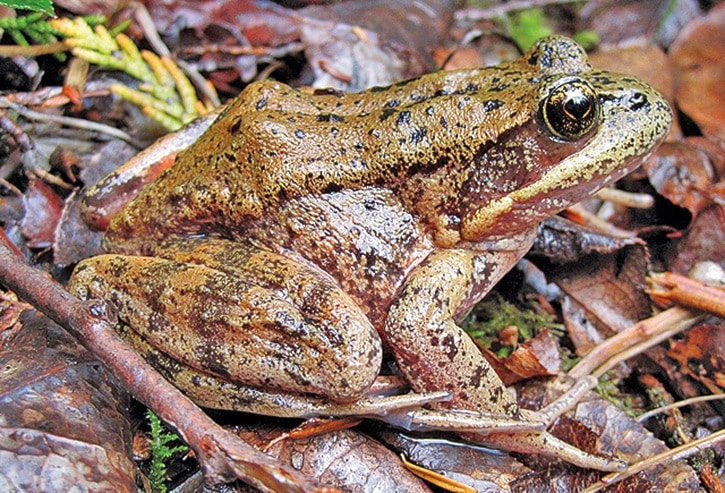The West Coast is hopping.
Red-legged tree frogs are listed as a species of special concern by the Committee on the Status of Endangered Wildlife in Canada but they are thriving on the West Coast and the Association of Wetland Stewards for Clayoquot and Barkley Sounds is working hard to keep local populations abundant.
“They’re a symbol of how wild the West Coast is and how wild Ucluelet and Tofino still are and we should cherish that and try to make sure that we maintain them,” the association’s Barb Beasley told the Westerly News.
“We’re so fortunate we still have tree frogs. They’re an iconic species that is amazing. You don’t have tree frogs living in a lot of places in the lower mainland anymore because it’s either too polluted or there’s too much development and not enough habitat left for them or there’s too many roads for them to get squashed on.”
Red-legged tree frogs breed in the winter and Beasley said she discovered this year’s first crop of egg masses in February.
“They’re interesting because they need to breed in fresh water areas that are still. They don’t breed in creeks, they don’t breed in shade and they need to be in water that’s at least 40 centimetres deep,” she said.
The creatures live up to 15 years and breed annually with females typically laying their eggs in the same spot every year, according to Beasley.
“The female is attracted to a place where the male is calling but what’s cool about the red legged frogs is that the red legged frogs call underwater so you don’t actually hear the red legged frog calling unless you have hydrophone,” she said. “It’s amazing actually. You’ll be at a site and put a hydrophone in and suddenly there’s an incredible chorus of song that the males are singing underwater.”
She said a healthy frog population illustrates a healthy ecosystem.
“Amphibians are really sensitive in that they have no external covering on their skin, so everything that’s in the atmosphere and in the water is absorbed directly into their bodies,” she said. “Because they’re so sensitive they are seen to be one of the best indicators of healthy atmospheres and soils and water.”
She said it is important to keep the Coast’s population healthy because red-legged tree frogs provide valuable ecosystem services.
“The tadpoles themselves are what are considered ecosystem engineers because they graze algae…and when they do that they make room for more algae to colonize and so they actually increase the productivity of algae and primary productivity in the pond,” she said.
“It’s essential for everything in the world to live. If we didn’t have primary productivity we wouldn’t have oxygen and we wouldn’t have food for the primary levels: primary herbivores that then feed our carnivores that continue to feed everybody else.”
As they evolve from tadpoles into frogs their importance to local ecosystems continues because they stay true to their original homestead and never wander more than 7 kilometres away.
“They’re very, very, faithful to their breeding sites; they go back to where they’re born to breed. They migrate back and forth to where they’re breeding to wherever they go to hang out, forage and live throughout the rest of the year,” Beasley said.
“Frogs and salamanders are born, raised and grow up in the wetlands and then these are little nutrient packets that move into the forest…They’re transferring nutrients from one type of ecosystem, or one habitat, into another.”
Their penchant for exploring makes the little animals susceptible to highway traffic so the association built a tunnel under Hwy. 4 in 2013 to help them get across without getting run over.
“We know there’s lot of amphibians moving through it and we also know there’s lots of other wildlife moving through it,” Beasley said.
She hopes to dive into further research about the tunnel, specifically regarding whether predators are taking advantage of the frogs funneling through.
“When they get to the highway at this one tiny spot we’re trying to channel them through a culvert, well then there’s the opportunity for predators to potentially learn about that,” she said.
“So, we’re trying to find out whether or not that’s happening and whether the risk of getting killed by a predator going through a tunnel is higher or lower than getting killed by a car.”
Beasley is also hoping to look into a population of red legged tree frogs living in a small pond at Tugwell Fields and said a survey the association conducted there about three years ago suggested that population was in trouble.
“I am worried that that population may not be doing very well,” she said.
She said the pond is rich in nutrients and algae but its surroundings offer little cover for the frogs to travel since the district removed invasive scotch broom from the area several years ago. Frogs require cover to move around as they can dry up quickly if exposed to sunlight and Beasley said Tugwell’s frogs might have become stranded when that broom was removed without being replaced by native vegetation.
“You do wonder whether the frogs actually can leave or, if they do leave that specific site, how far do they go? There’s not a lot of cover for them,” she said. “One of the main things is providing them with some more habitat and connections to habitat that’s around them…The first thing to start with would just be trying to plant native vegetation that’s within five to 10 metres around the edges of that pond.”
The association has ample opportunities for people wanting to make some deposits into their karma bank by helping a local species thrive and anyone interested in lending a hand is encouraged to reach out to wetlandstewards@gmail.com.
